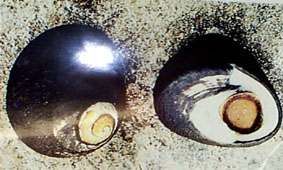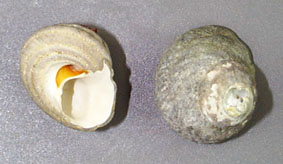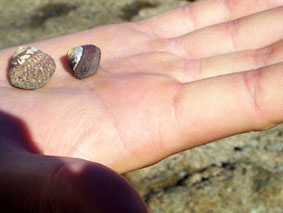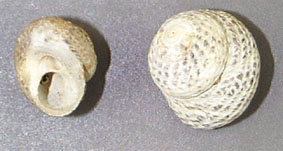
Turban snails and limpets are mollusks and belong to the Class Gastropoda. The classification of the specific species is outlined below:
Members of Phylum Mollusca are a diverse group characterized by the presence of a fleshy mantle that secretes a calcareous shell. Members of this phylum possess bilateral symmetry and a true coelom. Molluscs have true protostomal development. An important structure present in most molluscs, except for bivalves and aplacophora, is the radula. The radula is a complex rasping structure used for feeding. Molluscs typically have an open circulatory system (except for cephalopods) complete with heart, blood vessels, and respiratory pigments.
The turban snails and limpets belong to Class Gastropoda; One of seven classes assigned to the Phylum Mollusca. Gastropods are characterized by torsion, a process that results from twisting of the mantle cavity. The process of torsion takes place during the veliger stage of development. Most members of Gastropoda possess a muscular foot that is used for locomotion. Gastropods are recognized as having a true head with developed sensory organs.
Turban snails and limpets are members of the Subclass Prosobranchia. Prosobranchs are characterized by having their ctenida located anterior to their heart in the mantle cavity. Most prosobranchs have a well developed shell and in all but a few species the lateral nerve cord remains twisted after torsion. Typically sexes are separate, however, in some species there is hermaphroditism.
Turban snails and limpets are members of the Order Archaeogastropoda. All members of the Order Archaeogastropoda come from a single ancestral form. Members of Archaeogastropoda have rhipidoglossate radulae consisting of numerous rows of teeth. Archaeogastropoda is a large poorly defined group whose members possess one or two ctenida in their anterior mantle cavity.
Members of the Superfamily Trochacea are best described as having shells of spherical to conical shape with several whorls. The interior of the shells is mostly nacreous which gives the shell a pearly appearance.
The Family Trochidae features an opeculum made of chiton. Members of the Genus Tegula can be distinguished from other genera within the Family Trochidae by their medium-sized top shells that very in color. These shells are distinctively smooth to ribbed. Members of the Genus Tegula are sometimes called the "Top Shells" because of their pyramidal shape. Members of this Genus are mostly herbivores but some Tegula species will feed on sponges, hydrozoans, and hydroids.
Tegula funebralis is found in tidepools and on rocks in the middle intertidal zone in protected coastal areas. T.funebralis can be found from Vancouver Island(British Columbia) to Baja California. As are most of the Tegulas,T. funebralis feeds mostly as a grazer on microalgae found on rocks. T. funebralis is poorley defined in the fossil records.

Tegula aureotincta is common to the low intertidal zones and on adjacent rocky subtidal shores ranging from Ventura California to Baja California. From studies conducted on the radula this species of tegula seems to be closely related to T.brunnea. T. aureotincta can be found foraging on microalgae close to the substratum.

Tegula gallina can be found within the middle intertidal zone in tidepools and among rocks. T. gallina can be found in waters from Santa Barbara to Baja California. T. gallina as well as most other hebivorus gastropods enhance microbal activity in the intertidal and sublittoral zones by the trailing of mucus.

Tegula eiseni is common in rubble and on rocks of the middle intertidal zone and in subtidal kelp forests. T. eiseni ranges from Los Angeles Co. to Baja California. T. eiseni can sometimes be found around kelp where they can often take refuge from prey.

Tegula funebralis (Adams 1855) Common name- Black turban snail. The black turban snail usually grows up to 30 mm in diameter, body is whorled with weak spiral patterns and a spiral band below the suture. The shell is dark purple to black (black if wet). The foot has black coloration on either side. Black turban snails are found in tidepools and on rocks in the midintertidal zone, from Vancouver Islands (British Columbia) to Baja California.
Tegula gallina (Forbes 1852) Common name- Speckled turban snail. The speckled turban's body is whorled like that of T.funebralis but lacking the shell is a paler gray to greenish color. Also T.gallina is lacking the spiral band below the suture that is found in T. funebralis. Stripes of white in a checkered or zigzag pattern, with a commonly eroded apex showing an orange color are common in this snail. The shell grows up to 35 mm in diameter and is common in tidepools and among rocks in the midintertidal zone. This species is found from Santa Barbara county to Baja California.
Tegula eiseni (Jordan 1936) Common name- Banded turban snail. The banded turban snail has a brownish shell with large whorls bearing several nodular spiral ribs. The umbilicus found on this species is deep. Its shell is that of 25 mm in diameter. The snail is common in rubble, on rocks of the mid and lowintertidal zones and it is also found in subtidal kelp forests. This species is found from Los Angeles county to Baja California.
Tegula aureotincta (Forbes 1852) Common name- Guilded turban snail. The guilded turban has a shell that grows up to 40 mm in diameter, and has broad, low, spiral ridges prominent on the base. The shell is dark gray or olive on top. On the bottom, around the umbilicus, yellow or orange colors are found. From studies done on the radula this species may be closely related to T. brunnea. This species is common in the low intertidal and on adjacent rocky subtidal shores. This snail is found from Ventura county to Baja California.
1a. Shell has umbilicus 2
1b. Shell has no umbilicus 3
2a Umbilicus is present, shell of brownish color, evenly spaced spiral ridges, ridges are coarsely textured...... Tegula eiseni
2b Umbilicus is present with an orange skin around the area. Strong spiral cords on base, weaker cords on body, whorls crossed by diagonal ridges.......... Tegula aureotincta
3a Narrow spiral band below suture, solid black shell with weak spirals, base with broad white area .................Tegula funebralis
3b No spiral band below suture, no basal white area, shell color from gray to green, stripes often have zigzag pattern................. Tegula gallina